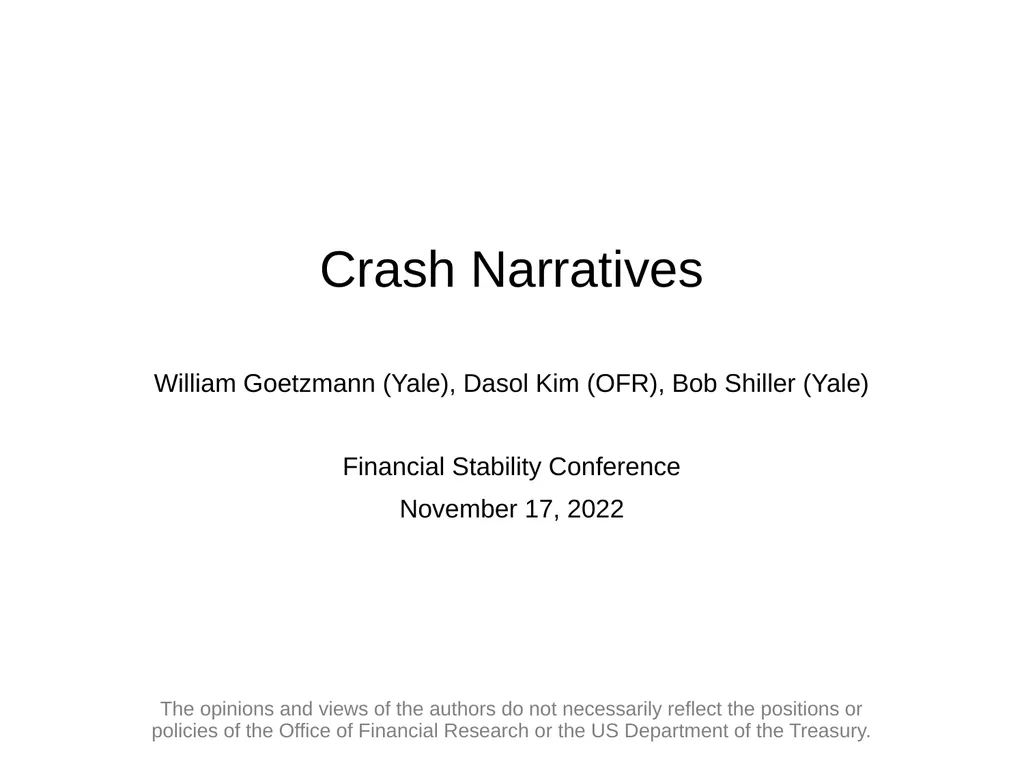Crash Narratives William Goetzmann (Yale), Dasol
Author : cheryl-pisano | Published Date : 2025-05-17
Description: Crash Narratives William Goetzmann Yale Dasol Kim OFR Bob Shiller Yale Financial Stability Conference November 17 2022 The opinions and views of the authors do not necessarily reflect the positions or policies of the Office of
Presentation Embed Code
Download Presentation
Download
Presentation The PPT/PDF document
"Crash Narratives William Goetzmann (Yale), Dasol" is the property of its rightful owner.
Permission is granted to download and print the materials on this website for personal, non-commercial use only,
and to display it on your personal computer provided you do not modify the materials and that you retain all
copyright notices contained in the materials. By downloading content from our website, you accept the terms of
this agreement.
Transcript:Crash Narratives William Goetzmann (Yale), Dasol:
Crash Narratives William Goetzmann (Yale), Dasol Kim (OFR), Bob Shiller (Yale) Financial Stability Conference November 17, 2022 The opinions and views of the authors do not necessarily reflect the positions or policies of the Office of Financial Research or the US Department of the Treasury. “When Land Becomes Water…” Narratives in Collective Memory Few people experience extreme market crashes in their lifetimes, and most often rely on collective rather than personal memory. Collective memory is usually represented by narratives rather than comprehensive accounts. Narratives generally elicit causal relationships, providing analogies for how and why things happen, and what the future might be. Financial press is an important conduit. Journalists may use narratives to contextualize current events. Choice of narratives is subjective, and may not be necessarily congruent with actual conditions. Investors may rely on media narratives to form beliefs and inform choices, implying aggregate market feedback (Shiller, 2017). This paper examines the role of financial media in propagating narratives that may go viral. Overview Develop a measure of media narratives using articles published following major market crashes, i.e., crash narratives. Strong association between crash narratives and traditional market- as well as survey-based crash indicators. Evidence of virality of media narratives, feedback on market volatility. Investors revise crash assessments following the appearance of crash narratives in media, and parrot the same language in written responses. Media increases general or pure narrativity during periods of high investor attention. General narrativity drives main results. Related Literature Financial and economic narratives. Bybee et al. (2021), Bertesch et. al. (2021), Larsen et. al. (2021), Dierckx et al. (2021). Rare disasters. Reitz (1988), Barro (2006), Weitzmann (2007), Santa-Clara & Yan (2010), Berkman et. al. (2011), Bollerslev & Todorov (2011), Wachter (2013), Welch (2015), Goetzmann, Kim & Shiller (2022). Memory models. Mullainathan (2002), Gennaioli and Shleifer (2010), Kahana (2012), Bordalo et. al. (2017), Enke et. al. (2019), Wachter and Kahana (2019), Goetzmann, Watanabe & Watanabe (2022). What is a Narrative? Economic narratives are contagious stories with the potential to change how people make economic decisions independent of fundamentals (Shiller, 2019). Narrativity is a set of qualities or properties that distinguishes narratives from non-narrative texts (Herman, 2009): Situatedness (voice indicating occasion for telling) Relevance of event sequencing (causality) Worldmaking, disruption (disequilibrium) What it’s like (experience of story-world) Quantifying narratives (or narrativity) is intrinsically difficult as it involves high-dimensional semantic representations. Article from September 16, 2008: If you learn














![[READ]-Fortran Crash Course + Hacking + Android Crash Course + Python Crash Course + XML](https://thumbs.docslides.com/972403/read-fortran-crash-course-hacking-android-crash-course-python-crash-course-xml-crash-course-hacking-xml-python-android-book-2.jpg)